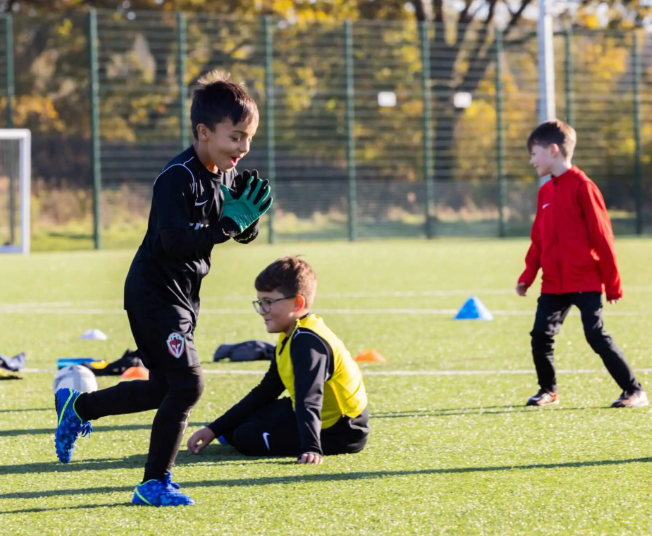As a parent trainer, I’ve spent countless hours figuring out the best way to help my child develop their soccer skills at home. Training can feel like a grind, and it’s challenging to strike the right balance. You want to keep things tough enough to encourage improvement, but not so difficult that it leads to discouragement. The key is to align what you want to achieve with what your child can realistically accomplish, creating a system that supports growth without causing stress.
Let’s dive into how to set up a practical system that encourages improvement.
Establishing Clear Rules and Boundaries
When I started training my sons, I quickly realized that introducing a few simple rules and constraints made a huge difference. For instance, when working on juggling, I might set a challenge: “You have 10 attempts to juggle the ball 50 times. If you don’t succeed, you get 10 more tries.”
This creates a clear goal. If my son doesn’t hit the target, he knows what’s next—more attempts. The system handles the structure, not me, which is crucial. However, it’s important to make sure the challenge is achievable. Setting a goal that’s too difficult can cause frustration and burnout. You need to understand your child’s limits and create a system that pushes them while still being manageable.
The Goal Is Clarity, Not Always Fun
You’ve probably heard a lot about “gamifying” exercises to make training more enjoyable. But here’s the reality—I don’t buy into the term “gamify” because it suggests everything has to be fun. While it’s great to add some enjoyment, training, especially when focusing on fundamentals, can’t always be about fun.
I’ve never met a child who genuinely enjoys doing the same repetitive exercises. Whether it’s juggling or dribbling, it’s hard work. So, rather than trying to make it “fun,” I prioritize clarity and transparency. The goal is clear, measurable, and achievable. My son knows exactly what to do, and if he doesn’t meet the goal, there’s a small consequence—extra attempts.
This method of setting clear rules makes the process smoother. You’re not constantly giving instructions; you’re letting the system do the work and giving them the chance to succeed.
Stepping Back and Letting the System Work
One of the mistakes I made early on was trying to be the constant coach—always correcting form, giving advice, and explaining. But this just added unnecessary pressure.
Eventually, I realized that stepping back and allowing the system to take over was key. Now, I act more as a referee than a coach. For example, during a juggling session, I just call out the numbers, and my son focuses on completing the task. If he doesn’t make it, he knows the consequence—extra attempts. If he succeeds, we move on. I don’t need to say anything else.
This approach allows my son to take control of his own progress. He starts self-correcting. Instead of me telling him not to kick the ball too hard, he learns that if he doesn’t control it, the ball will go out of bounds, resulting in extra juggles. This self-correction is the beauty of the system—it encourages them to think about the game without constant reminders from me.
Adjusting the Environment for Success
When we train, I also set up the environment to match my child’s skill level. For instance, with my younger son, I create a larger area for juggling since he’s still working on ball control. For my older son, the area is smaller, reflecting his higher skill level. By adjusting the space to their abilities, I ensure that both feel challenged but capable of succeeding.
Additionally, I build in mini-challenges. Instead of just saying, “Juggle the ball,” I set a target: “You have 10 attempts to juggle 50 times.” If they fail, they know the next step—extra attempts. Over time, this approach helps them build discipline and consistency, and it teaches them to focus on completing the task at hand.
Stretching Limits Without Overwhelming
As they improve, I gradually increase the difficulty. Once they master juggling with their laces, I introduce new constraints, such as not using the inside of their foot or requiring two consecutive touches with their left foot. If they break the rule, they get five extra juggles. This adds challenge without overwhelming them. They’re not being punished; they’re just being stretched to do more.
The goal isn’t to make training miserable but to create an environment where they can grow, enjoy the challenge, and feel accomplished.
The Power of Clarity and Consistency
The secret to effective training is clarity and consistency. Your child should know exactly what they’re working toward and have a way to track their progress. By setting clear boundaries and rules, you remove frustration and focus on improvement. As a parent, your role is to guide them, not be a constant coach. Let the system handle the structure and discipline.
It might seem like a lot to manage, but once you establish these systems, they become second nature. And remember, it doesn’t have to be perfect. You can always adjust as you go along. Training doesn’t need to be a battle of wills; by making it clear and measurable, you help your child develop skills and enjoy the process.
Final Thoughts
Ultimately, my goal is to create a training environment that works for both my son and me. I want him to improve while staying motivated, not frustrated. Using these simple constraints to align our incentives strikes the right balance between challenge and motivation.
















